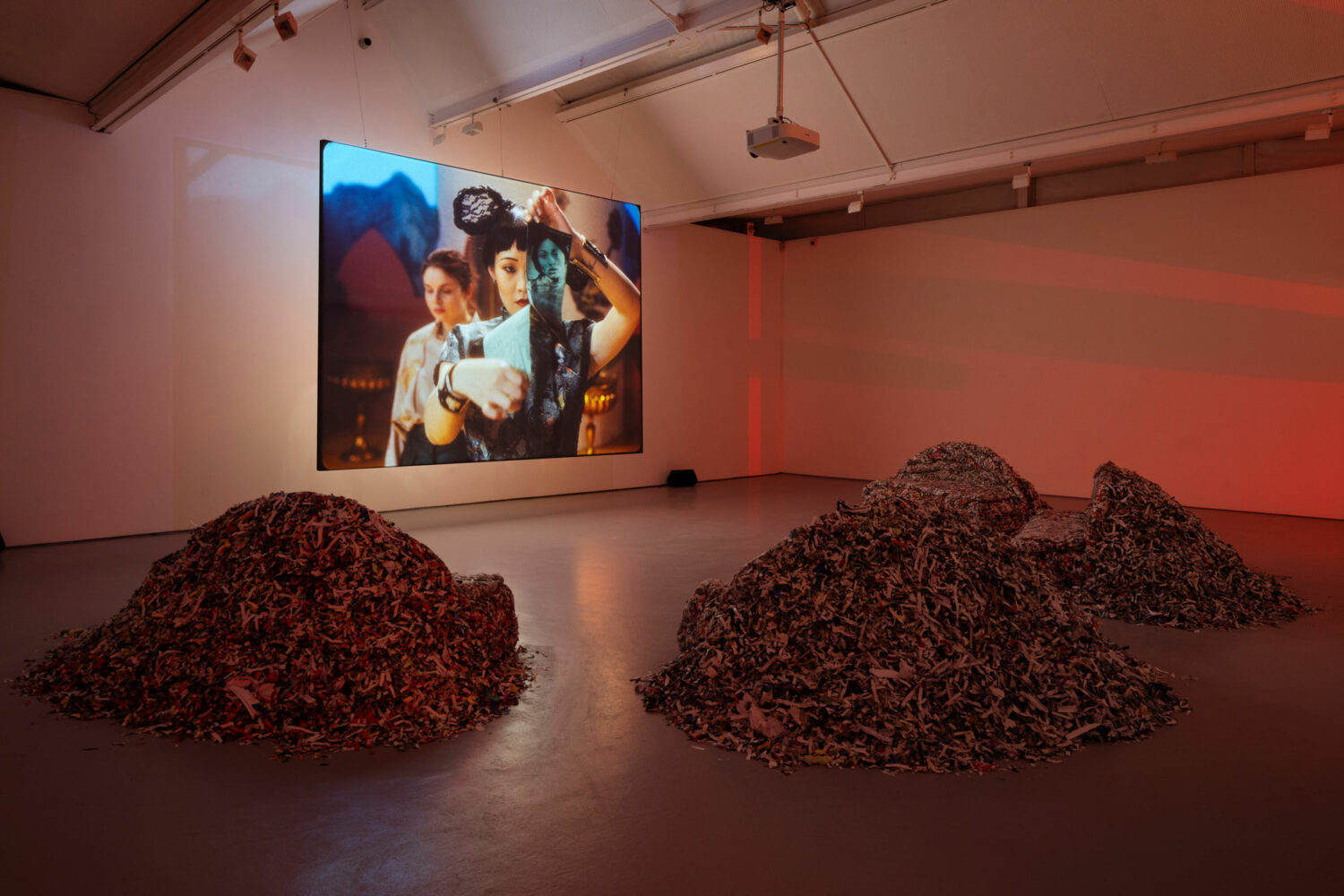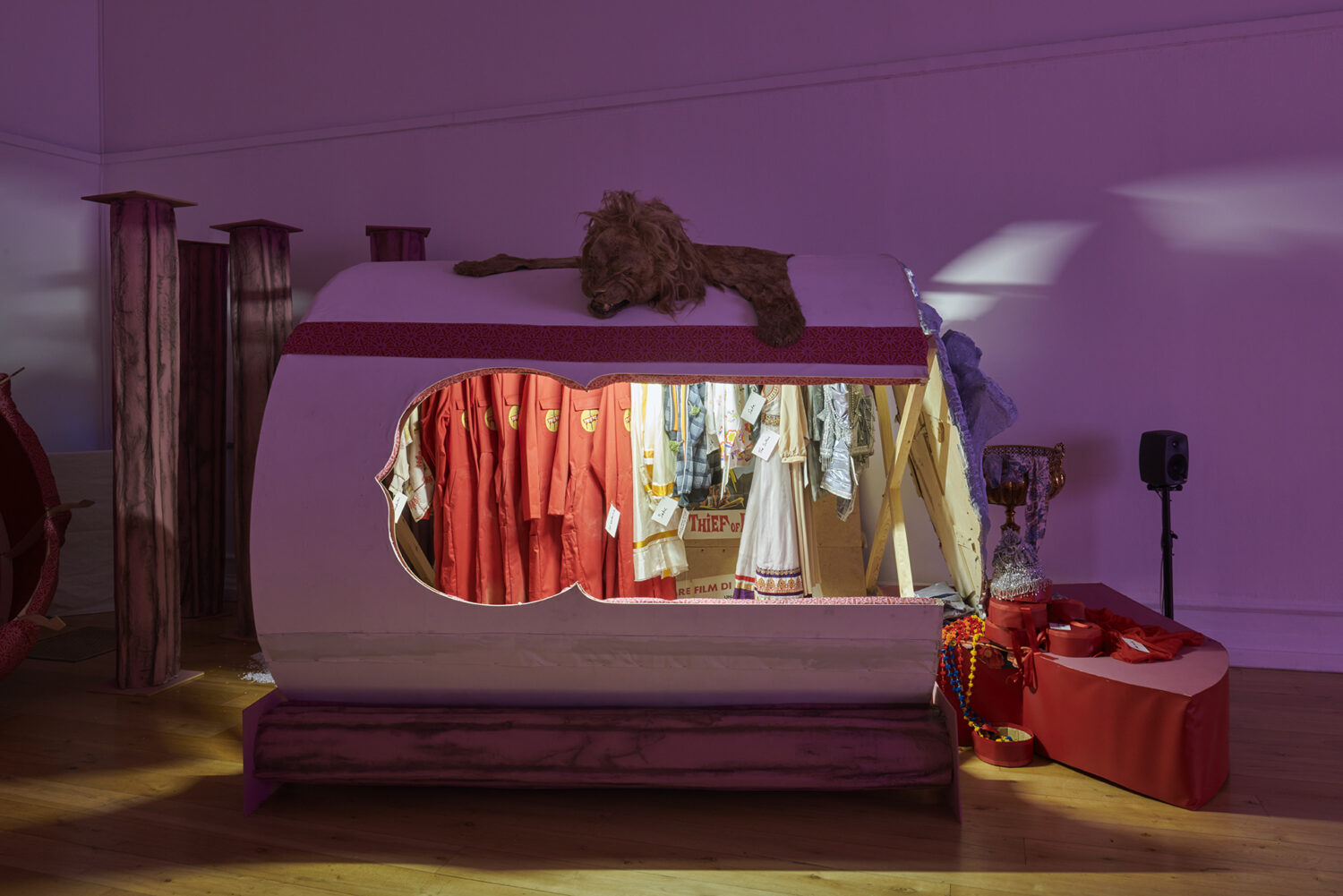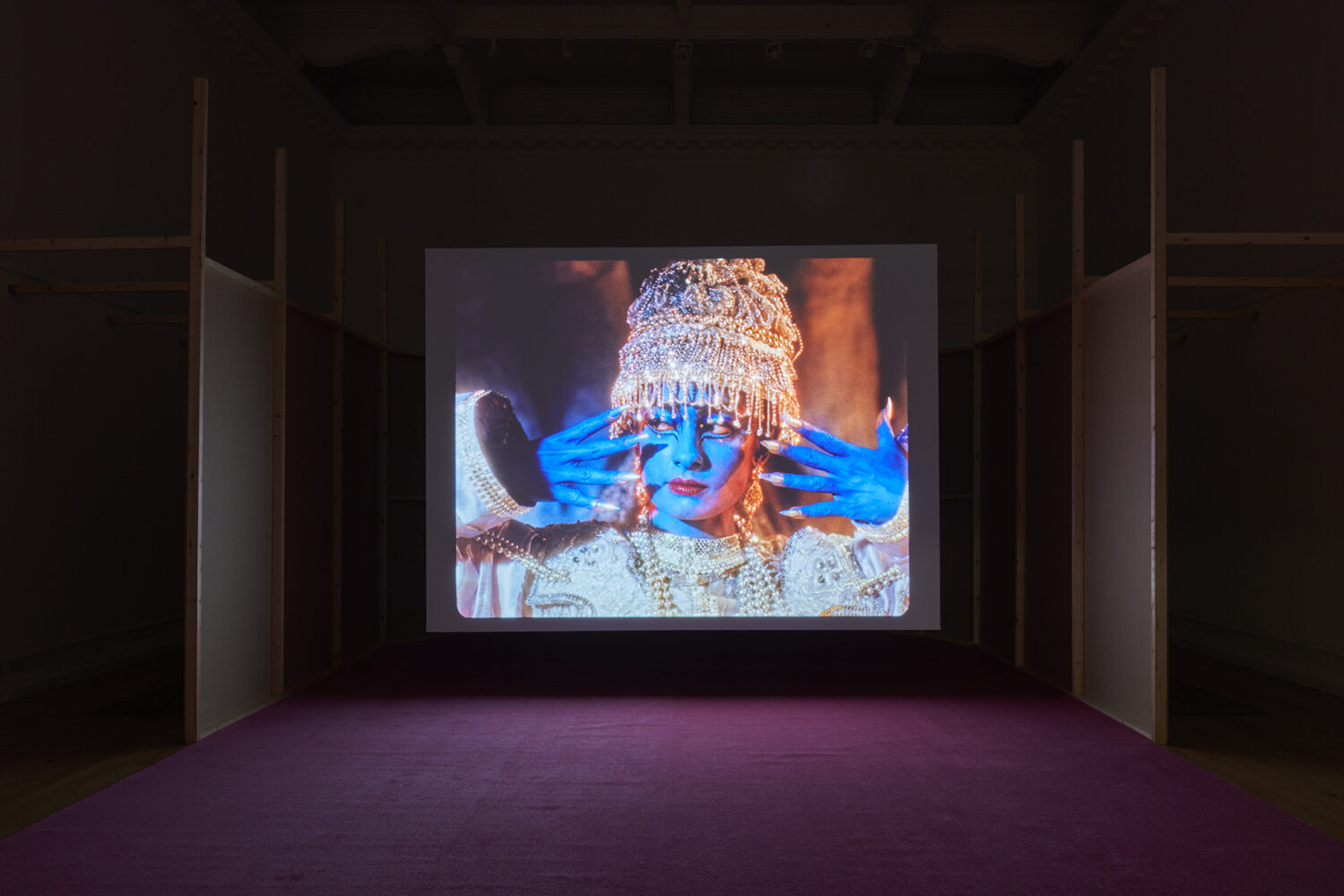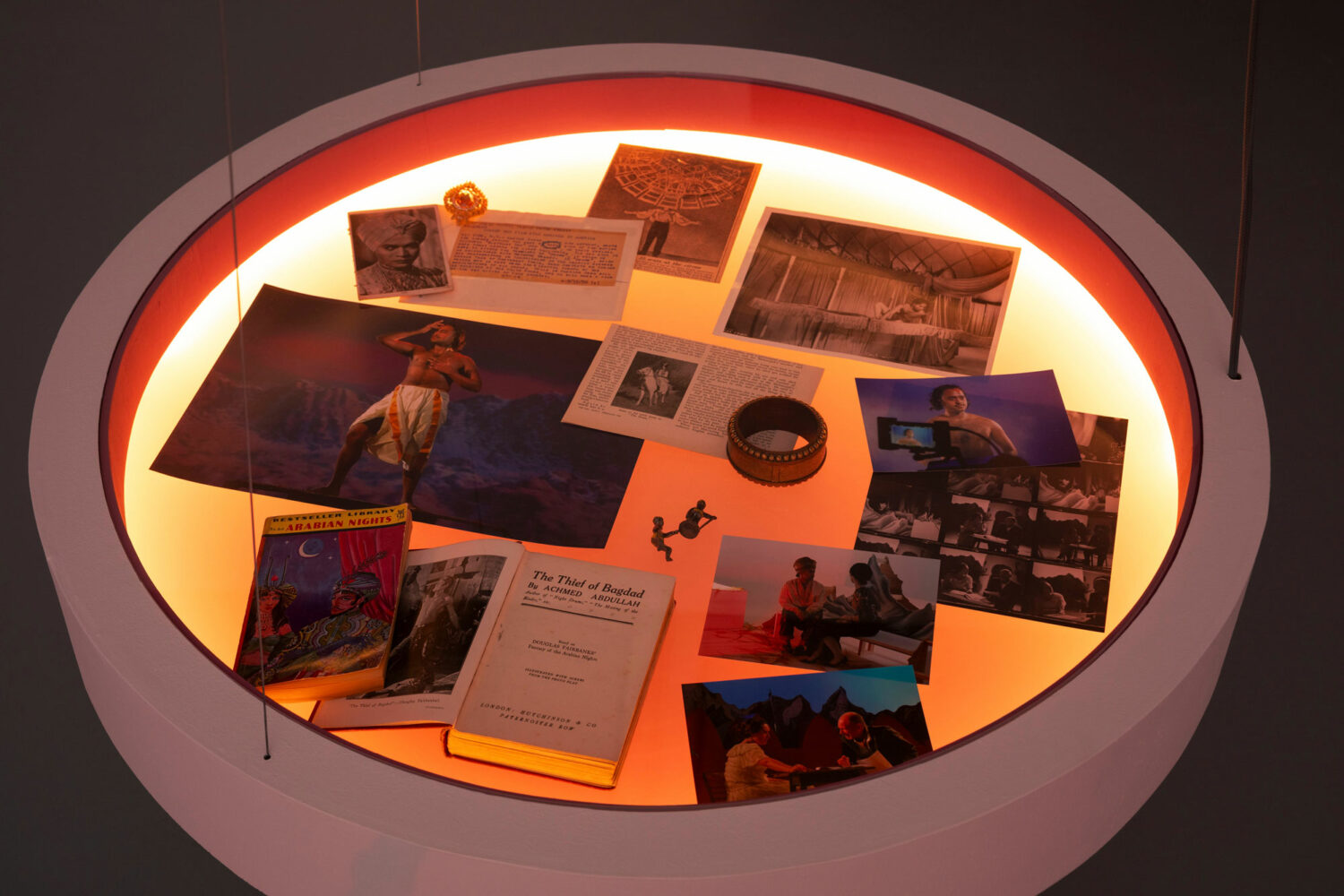Interview: Michelle Williams Gamaker Challenges Cinema’s History of Discrimination
By Keshav AnandBritish-Sri Lankan artist Michelle Williams Gamaker delves into themes of race, identity, her passion for cinema, and the power of storytelling through her dynamic practice. Her latest solo exhibition, Our Mountains Are Painted on Glass, debuted at DCA galleries over the weekend and will be on display until 24 March 2024. The show features her new film, Thieves, which was first premiered at South London Gallery. Renowned for her innovative approach to filmmaking and screenwriting, Williams Gamaker revisits and unpacks the influential movies that shaped her upbringing.
Drawing from the rich heritage of early Hollywood and British cinema, Thieves is a fantastical adventure that reinterprets The Thief of Bagdad, a 1924 silent, black and white film later remade in colour in 1940. Williams Gamaker transforms marginalised characters into protagonists in her work, actively challenging the industry’s history of racial discrimination. At DCA, the new project is presented alongside components of the film’s set, sculptures, and props. To learn more about Williams Gamaker’s practice and the ambitious new exhibition, Keshav Anand spoke with the artist.

Keshav Anand: Tell us about Our Mountains Are Painted on Glass — how did you come up with the show’s title?
Michelle Williams Gamaker: The title of the show is taken from British film director Michael Powell’s reference to the matte set glass paintings of Percy Day’s recreation of the Himalayas for the 1947 film Black Narcissus. The shift in tense from “were” to “are” was my hope to bring the precarity that this sentence embodies to the fore. Placing mountains on glass seems like an impossible, almost dangerous prospect and what I wanted for the exhibition was to bring back something of the fantasy world building of Hollywood and British Studio productions, while also not shying away from the problematic labour politics of this period that marginalised actors of colour, limiting their creative agency. The exhibition stems from my desire to share what I call Fictional Revenge, which is part of my Critical Affection trilogy within the context of an immersive installation.
KA: I love the idea of reimagining marginalised characters from existing films into leading roles — could you expand on this aspect of your practice?
MWG: I’m a cinephile and with hindsight I can see how much I was shaped by the films I watched as a child and teenager. Unconsciously, I always tried to find myself somewhere on screen; I harboured a secret fantasy to be an actor too, which only found expression through performance art in my 20s. The films I watched via the TV or renting VHS tapes were very much rooted in classic Hollywood and British cinema, alongside all the US blockbusters from the 80s on. When I did see performers of colour, they often appeared in fleeting sidekick roles, or individuals like Sabu genuinely intrigued me, because he seemed to operate with a different status, albeit limited.

In my previous films, I have explored the marginalised characters from Black Narcissus (Dissolution Trilogy 2017-19) and more recently the careers of Sabu and Anna May Wong. To my delight I found out that they both starred in The Thief of Bagdad. Anna in the 1924 Douglas Fairbanks black and white film and Sabu in the 1940 Alexander Korda Technicolor film. This gave me the vehicle to unite Sabu and Anna as Fictional Activists or allies, who could work together to take over the film set and demand justice for their replacement by white actors participating in racist practice by using brownface and costuming.
KA: What is the thinking behind the selection of works being shown at DCA galleries; and how have you thought about using the building’s architecture as a site of display?
MWG: The wonderful galleries at DCA have offered me the opportunity to exhibit The Bang Straws (2021), which is the prequel to Thieves (2023) and focuses on the casting discrimination of Anna May Wong. I will also show The Eternal Return (2019) from my Dissolution Trilogy, which looks at Sabu nearer the end of his career, when the studios no longer wanted him and he had to perform in a circus to support his family. It is my hope that viewers will be able to unpack my overlapping archive of film stars, and also dive into my extensive collection of movie memorabilia of these stars.
We are constructing some architectural elements too, so that the exhibition has the feel of a discarded film set. Props from the film will be exhibited alongside production stills, collage and print. This is my biggest show to date, a mini-survey so to speak, and I love being able to see how entangled all these obsessive associations are from my studio, films and archive.

KA: I imagine it can be hard to discern, as it’s so embedded, but how do you feel your British-Sri Lankan identity has impacted your approach to making art?
MWG: This one is a little more tricky to answer, because my Sri-Lankan identity has always been bound in a diasporic understanding – rather than first hand. I suppose it always meant that my relationship to Britishness could only be understood by this other identity that forms me, and with this I have always sought to tell stories of those marginalised, but without wanting to repeat hopeless narratives. I’m interested in political articulation, through words and the body, and I love the idea that the characters I write for have the capacity to speak back to the power structures they operate within.

KA: Can you talk about your use of colour, particularly in relation to storytelling?
MWG: Colour is so important in my work, or more precisely when to work in colour and when to work in black and white. I hope my films can be read as formally inventive, I often work with alternating scenes of colour and black and white, or in the case of Thieves, the 1924 Anna May Wong finds herself on the 1940 set of The Thief of Bagdad. She wakes up in black and white while everything else is in Technicolor. Returning to Michael Powell, he once said of Black Narcissus that “Sometimes in a film its theme or its colour are more important than the plot,” and that has always stuck with me. I am trying to use colour to explore texture, mood and atmosphere. I feel colour can also carry politics and meaning. The new film I am working on, Strange Evidence, is a genre bending Film Noir Body Horror, focusing on film star Merle Oberon. I will be employing black and white and saturated colour to tell her story.
KA: Changing pace for a moment, what are some of your favourite places to eat in London?
MWG: My eldest daughter Julia loves ramen, and we share this passion. We love the restaurants along Sayer Street in Elephant and Castle, and the Japanese restaurant Taro on Kennington Road. When I’m working a long shift at my studio at Gasworks, I’ll pop into Korean restaurant Daebak on Kennington Lane – they do delicious tofu bibimbap!
Feature image: Michelle Williams Gamaker, Our Mountains Are Painted On Glass, commissioned by Dundee Contemporary Arts and South London Gallery, 2023. South London Gallery installation photography by Jo Underhill